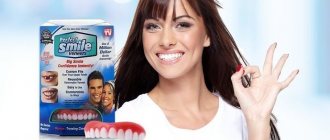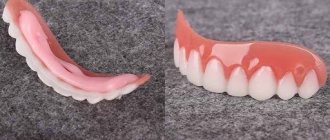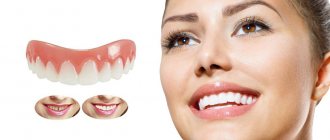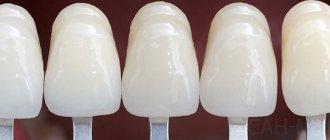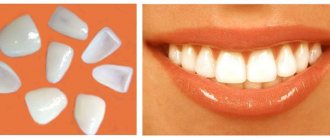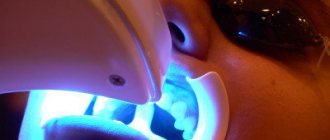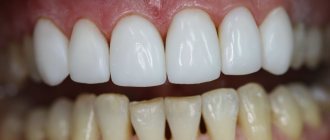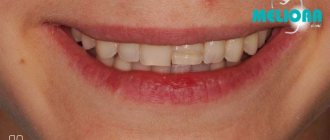- 1 Is it possible to install veneers without preparation?
- 2 How to care for veneers?
- 3 Pros and cons
- 4 Recovery period
- 5 Indications
- 6 Dental veneers perfect smile vaneers
- 7 What are Perfect Smile Veneers?
- 8 Veneers from E.max CAD –
- 9 What types of veneers are there? 9.1 Composite veneers
- 9.2 Ceramic veneers
- 9.3 Hollywood laminates
Is it possible to install veneers without preparation?
Fixing dental onlays without preliminary grinding is possible, but only with minor tooth defects. To avoid grinding down teeth, lumineers are most often used - ultra-thin microprostheses. They are more expensive than ordinary veneers, but they protect teeth even more reliably than native enamel. If your teeth are significantly crooked or uneven, it is not recommended to use lumineers.
We invite you to familiarize yourself with Dental Surgical Office Equipment
You can also install veneers without grinding on small teeth with noticeable gaps. In this case, the procedure will achieve a good cosmetic effect.
How to avoid becoming a victim of scammers
To avoid becoming a victim of scammers, I recommend adhering to the following rules:
- You should only buy veneers from trusted sites.
- If the site is unfamiliar, then carefully study the site and read reviews about it before making a purchase. It is better not to contact an online store that has no reviews or they are negative.
- You also need to pay attention to the cost of the product. If it is suspiciously low, you should know that most likely this is a cheap fake.
In the publication How to get scammed with a stolen and found wallet, you can read how not to become a victim of deception because of your own greed and what to do if someone else’s wallet is found.
How to care for veneers?
Veneers require careful and thorough care, although everything is not as complicated as it might seem at first glance. For any person who respects hygiene, caring for the pads will not be a problem. And following simple rules will maximize the service life of microprostheses.
- Brushing your teeth with high-quality toothpastes twice a day is the first and most important condition for maintaining healthy teeth under veneers. It is unacceptable to use brushes with hard bristles or cleaning compounds with abrasive particles.
- Periodically, you should have your teeth professionally cleaned at your dentist's office. This will allow you to clean hard-to-reach areas, which is not always possible at home.
- Gnawing on hard foods (carrots, candies, goats, nuts, etc.) should be done as little as possible, or it is better to refrain from doing so altogether.
- It is advisable to quit smoking. Tobacco has a negative effect on the color of tooth enamel, so even the best quality plaques can become darkened by cigarettes over time.
- Take care of the veneers and avoid hitting the area where they are fixed. When engaging in active sports, it is necessary to use protective structures for the jaw.
- Monitor the health of your gums. This is especially true for areas with which microprostheses come into contact. Due to tight contact, the gums may swell and bleed. You must not allow the inflammatory process to begin, otherwise you will have to start the smile restoration all over again.
- If irregularities and gaps appear in the areas where the microprosthesis is attached to the tooth, you should immediately visit the dentist to avoid the development of caries and inflammation.
Installing veneers is a quick and easy way to get a straight, dazzling smile without any effort.
It is only important to choose the right material and, of course, contact only reliable, proven clinics. And to maintain long-term results, you need to follow a few simple rules and carefully monitor the condition of your teeth and gums.
What materials are they made from?
Overlay removable veneers are made of polymers, silicone, polypropylene, and plastic in light shades. These are inexpensive materials, they are easy to process and can be easily painted in enamel colors. But we must understand that even in professional dentistry such materials are used only on a temporary basis, because they have low performance characteristics. The materials are softer and more fragile than those used for real microprostheses. They also have irregularities and pores on the surface, into which dietary fiber and dyes become clogged.
Advantages and disadvantages
Microprosthetics has become a wonderful remedy for many. However, every remedy has a downside.
The advantages of installing veneers include:
- Possibility to improve the appearance of teeth.
- The ability of the material to withstand large temperature differences and high mechanical loads.
- The linings are subject to restoration in case of damage or chipping.
- Quick correction of an overbite or malocclusion.
- Elimination of cracks and other damage to enamel.
Color is determined using the Vita scale. The marking is an alphanumeric index: from A to D and from 1 to 4. The letter indicates the shade, and the number indicates its intensity.
The disadvantages are the following:
- If the instructions for use are not followed, porcelain onlays may become damaged and composite onlays may crack.
- Before installation, preparation is carried out, due to which the original appearance of the tooth is completely lost.
- The service life of composite veneers is 3–5 years, after which they require replacement. In addition, the material darkens over time.
Ceramic dentures, according to most dentists, are of higher quality.
Product benefits or why people buy veneers
- Versatility: 1 size for everyone.
- Practicality: the device can be used in any situation.
- Ease of operation: storage of plates does not require special conditions.
- Strength: polypropylene is resistant to mechanical damage.
- Comfort: removing and attaching the product is very easy.
- Safety: the product is made of hypoallergenic material that is harmless to humans.
- Profitability: low price and long service life.
- Naturalness: there is no feeling of an artificial jaw.
Recovery period
There is no special rehabilitation period for installed veneers on the front teeth, so immediately after fixing the structures, you can return home to your normal lifestyle. However, in order for the products to last as long as possible, it is necessary to follow the doctor’s recommendations for oral care.
In most cases, a follow-up visit to the dentist is required so that the specialist can assess the condition of the gums and its reaction to the manufactured microprosthesis, and also check the position of the veneer on the front tooth surface and the reliability of the fixation.
Sometimes, after veneering vital teeth, hypersensitivity may occur, so a course of desensitizers will be required. In particularly difficult situations, to eliminate the increased response of teeth to thermal irritants, it is necessary to remove the pulp, and sometimes to cover the tooth with a metal-ceramic crown.
No special care is required for teeth covered with veneers:
- it is necessary to carry out daily oral hygiene using a brush and paste, which will allow the structure to maintain its shine and original appearance;
- it is advisable to limit foods that can leave pigmentation on the teeth, especially cigarettes, strong black tea, beets and blueberries;
- in order to avoid accidental chipping of part of the plate, increased chewing pressure on the front teeth should be avoided;
- Once every six months, visits to the dentist are required for a professional examination and possible correction of the product.
Veneers installed on the front teeth allow you to quickly correct aesthetic defects in your teeth and make your smile more attractive. To fix them, minimal grinding of the enamel is required, which is a less traumatic method of restoration than covering teeth with metal-ceramic crowns.
However, before veneering, you need to carefully study all the pros and cons of the procedure and consult a dentist about the possibility of installing such microprostheses.
In what situations are veneers irreplaceable?
People who have just decided to buy a removable smile are very interested in how and when to use Perfect Smile Veneers. The design is suitable for daily use. It can also be used for special occasions. A perfect smile that can be worn just before the holiday and will be the perfect decoration for a birthday, wedding or engagement anniversary. It is advisable to insert false jaws before important negotiations or interviews. When used correctly, the product is invisible and does not cause discomfort. Veneers will also help complement a magical image for a photo shoot, video shoot or video review.
Indications
Microprosthetics in some cases is the best solution to the problem.
Dentists recommend installing veneers in the following cases:
- For chips, cracks and uneven enamel.
- Change in color that cannot be bleached.
- Uneven row.
- For crooked or underdeveloped teeth.
- Pathological abrasion of enamel.
Russian technologies for manufacturing composites differ from Western ones. In European dental clinics, onlays are made in a special dental laboratory, and impressions are used after grinding and preparation. In Russia, dental plates are more like ordinary fillings. They are installed directly into the patient's mouth.
What you need to know before installation
You've already read how dental veneers are made step by step, and you've also looked at photos of finished smiles. Are you making up your mind? Please note the following points:
- The operation is completely safe if the preparatory procedures are carried out correctly.
- There is no upper age limit.
- Grinding is mandatory - some layer of the natural coating will definitely be removed, from 0.5 to 0.7 mm.
- The condition of the cutter under the plate does not deteriorate (if it is tightly fitted).
- The pad is not removable, but it can be chipped and any damage requires replacement.
- Microprostheses last the longest if you maintain oral hygiene and give up bad habits.
- Biting food after they have been secured should be done carefully; it is better to avoid gnawing hard objects.
Is there any way to install without damaging the enamel?
Not yet, and don’t believe those who promise otherwise. But don’t be upset, turning is necessary and in some ways even useful, because it prevents the plates from layering, clinging to each other, making the jaw heavier, and inflaming the gums.
Features of the glue used
It is applied to the inside of the lining. To ensure better adhesion, the surface of the cutter is degreased and also covered with an etching gel for 3 minutes, but to protect it from bacteria. At the end of this time, the area of exposure is dried and illuminated with a lamp. Excess materials are then removed and transition areas are polished.
Dental veneers perfect smile vaneers
For the first 10 minutes of wearing it, I felt somehow uncomfortable - my tongue was constantly swirling around the pad and I was even afraid to talk so that my “teeth” wouldn’t fall off. But then I got carried away by the conversation and even forgot that I had this overlay on my teeth - it stopped bothering me so much. I only removed the veneers when I went to bed. The first days I was afraid to eat in them - I thought they would fall out. How to properly put on Smile Perfect veneers But then I was convinced that they were holding firmly.
Before going to bed, I take out the pad and just wash it under running water. After a month of wearing it, there is no yellowing or any other damage. Milania Beautiful, but not their own Rating: But I came home, and when I was filming, I felt very sad, because my appearance changed dramatically. When I used it, I tried not to eat anything hard, I was afraid that the pad might fall off at the wrong moment.
The plate makes your teeth perfect: Before attaching the plate, you need to moisten it with water and press it to your teeth. This is enough to securely secure it to the teeth. The size is universal, so when ordering you don’t need to worry that it won’t fit. Can be worn for a long time. The cost is budget, but it is better to order from an official manufacturer so as not to run into a fake.
They are comfortable to wear and do not cause any discomfort. I get used to it within 20 minutes, and after that I don’t notice them. Turandot Solution to my dental problems Rating: My friends think that I got my teeth done. It can be used both on an ongoing basis and for isolated cases. There are no contraindications for long-term wearing.
Can be used by both women and men. The shape of the teeth becomes ideal, there is no darkening of the enamel. Veneers are easy to use. I first thoroughly brush my teeth, rinse the plate with water and fit it tightly to my teeth. This way they are fixed.
How much does a “Hollywood” smile cost?
How much do removable dental veneers cost? If you study the offers on various sites, the average price will be 1,200 rubles for a complete “transformation” of your smile. But, as practice and reviews of people who have decided to make such a change in appearance show, this is money down the drain. In reality, such products will not make your smile more beautiful, and they are impossible to wear.
If the patient is interested in the cost of temporary veneers, which need to be worn while the permanent ones are being made, then their cost, as a rule, is already included in the overall price tag. Those. there will be no additional costs. Classic non-removable ceramic onlays for teeth cost from 15 thousand rubles and more - it all depends on the cost of materials and methods of processing them. By the way, if necessary, the doctor will be able to remove them and install new ones if the need arises.
1Gurel G. Ceramic veneers, 2007.
Your questions and answers
QUESTION I bought removable veneers online, but I cannot attach them to my teeth. They fall off constantly. Tell me how to do this better? Alexandra
ANSWER Hello, Alexandra. Unfortunately, there is nothing we can do here. Because these are not veneers at all, but their imitation. Real veneers are installed in dentistry using a special adhesive composition - and remain on it for years. Also, real veneers are made based on impressions of the patient’s dentition, i.e. they are individual and precisely adjusted to the parameters of a particular person. Whereas “veneers from the Internet” are template overlays made according to standards known only to the manufacturers themselves. That's why they don't stick to the teeth. The use of any independently selected adhesives is unacceptable, as this can only harm yourself. Therefore, we do not recommend wearing these products. But you can use them for creativity, crafts - whatever your imagination allows.
What are Perfect Smile Veneers?
Innovative dental veneers Perfect Smile Veneers are special overlays that imitate the natural shape of teeth and are securely attached to their surface. The preferred method is to permanently install a series of Perfect Smile Veneers on the lower jaw or upper row. Modern production technology makes the pads removable. In dental clinics, veneers can be applied to teeth without the possibility of removing them.
At first, Perfect Smile Veneers seem unusual, like a foreign object in the mouth. Most patients no longer experience discomfort from the plates after 10 minutes, since they have a streamlined, natural shape and do not affect the bite. Externally, it is impossible to distinguish natural teeth from artificial plates. You can determine that veneers are installed on your teeth using special equipment or an examination of the oral cavity.
An important advantage of these veneers is that the Perfect Smile Veneers plate does not affect the integrity of the enamel and damage to the gums; installation is carried out at home
Special onlays - innovative dental veneers Perfect Smile Veneers
What is better to choose?
If you understand the question of which removable “veneers” are better, then the only option would be Snap-On Smile dentures. They are made individually and from quality materials. But, since the plant is located in the USA, the patient will have to wait about 1-2 months, and the main waiting time will be spent on transportation. Again, you will have to first visit an orthopedist to take impressions and sanitize the oral cavity. As a result, the final cost of treatment can be close to installing real veneers.
South Korean implant Osstem - 20,000 rub.
Hurry up to sign up for a free consultation and lock in promotional prices.
Call now or request a call
Opening hours: 24 hours a day - seven days a week
Veneers from E.max CAD –
Veneers from E.max CAD: before and after photos
Glass ceramics E.max CAD are lithium disilicate blocks designed for milling veneers and crowns on a computer-controlled machine (CAD/CAM technology) with virtually no human intervention. The process is as follows: first, the front surface of the teeth is ground down for veneers, after which a three-dimensional 3D impression is taken using an intraoral scanner.
Based on this impression, a computer program builds a 3D shape of future veneers, which is transferred to a computer-controlled milling machine. Next, future veneers are milled from E.max CAD ceramic blocks, after which there are still stages of firing, staining, glazing and fixing the veneers on the patient’s teeth (24stoma.ru).
Pros and cons of “E.max CAD” –
Yes, CAD/CAM technology is very modern, but it requires very expensive equipment, and this affects the cost of veneers. At the same time, the E.max CAD system has less capabilities for selecting shades of veneer color than E.max PRESS. Accordingly, the risk that the veneers will be slightly different from the neighboring teeth in shade and transparency will be higher.
The latter may be unimportant only if you use veneers to immediately replace all front teeth that fall within the smile line. But, if you need to make only 1-3 veneers only on problem teeth, then they may be noticeable against the background of neighboring teeth. In addition, the strength of veneers made from E.max CAD will be slightly lower - about 360 MPa, which is lower than the strength of veneers made from E.max PRESS of 400 MPa.
Well, the last thing that needs to be noted is that only standard veneers (0.6 mm thick and above) can be made from this material. For the production of so-called “thin veneers” with a thickness of 0.3-0.4 mm, which require minimal grinding of tooth tissue, or you can do without grinding the enamel at all - only E.max PRESS material is suitable. Thus, the latter turns out to be both stronger and cheaper, and has greater potential for creating ideal aesthetics.
Fixed plates - indications and installation
But let’s return to the question of what veneers and lumineers are in the classical sense. We are talking about very thin overlays that are fixed on the front side of the front teeth in order to hide their aesthetic defects, that is, to correct the shape and size of incisors and fangs, to disguise too large gaps between the teeth, to give the enamel a beautiful snow-white shade and vibrant shine. After such a procedure, your smile can be transformed beyond recognition.
In their classic form, veneers are immediately recognizable
The plates themselves are made from durable and aesthetic materials, most often from pressed ceramics or zirconium dioxide. There is also the option of more budget-friendly composite plates. By the way, with the help of a composite, teeth are literally grown in a direct way - the front surface of the incisors is covered with a photopolymer and immediately illuminated with a polymerization lamp, that is, all manipulations are carried out directly in the patient’s oral cavity.
If we talk specifically about the indirect method, then the thickness of one such structure usually varies from 0.6 to 0.8 mm. Therefore, before installing microprostheses, the doctor first grinds off a small layer of enamel in order to preserve the anatomical parameters and aesthetics. Each plate has a small protrusion at the base, which, after fixing the product, neatly overlaps the cutting edge, which increases its strength and improves other performance characteristics.
“When I was getting veneers, I agreed to have them trimmed myself, but honestly, I didn’t think that so much would be removed! I almost cried when I saw my smile after the dissection. Thank God they gave me removable plastic pads, otherwise I don’t know how I would have walked. With plastic ones, of course, it’s not very convenient, but what can you do? Now I’m waiting for my ready-made teeth to arrive from the States.”
Vikki, review from the women's forum woman.ru
But there is another option - ultra-thin plates with a thickness of 0.2-0.3 mm. The most popular brand that produces these types of pads is the Lumineers brand, which belongs to the DenMat company. To create ultra-thin plates, they use a special patented material called Cerinate, which is both highly durable and almost flawless in aesthetics. In some cases, when choosing ultra-thin onlays, it is possible to completely avoid grinding your living enamel.
Fixed plates are installed in patients using approximately the same algorithm. The universal sequence of actions is briefly described below:
Although turning the enamel is not always necessary, it is still one of the stages of action
- preparation, including treatment of carious cavities, replacement of old fillings, anti-inflammatory therapy if necessary, removal of plaque and deposits, selection of the shade of future restoration using the Vita scale,
- turning the enamel - removing a small layer of living hard tissue so that after installing the plates, the teeth do not look too voluminous and massive,
- making impressions or 3D scanning of the internal structures of the oral cavity,
- conducting photometry – fixing photoparameters of facial symmetry,
- bite modeling on an articulator or using advanced digital smile design software,
- installation of temporary plastic overlays to protect ground incisors and canines and temporarily hide aesthetic defects.
Once the permanent products are ready, it is time to remove the temporary overlays. Finished permanent veneers are attached using a special heavy-duty adhesive composition.
Classic non-removable plates are the best option if you want to get a highly aesthetic and durable result. Any removable structures aimed at aesthetics are acceptable only as a temporary measure, and many of them are not suitable for use at all, being only a product of an advertising gimmick.
What types of veneers are there?
There are 2 types of microprostheses under consideration, the classification is based on the material of manufacture. Types of veneers:
- composite;
- ceramic.
On the eve of choosing the devices to be installed, the dentist must explain in detail what veneers, lumineers and ultraneers are, and name their differences. The last mentioned types of microprostheses are much more expensive than standard onlays. They are produced and attached using a similar technology, but their use does not require severe damage to natural tooth enamel.
Composite veneers
Such devices are made of organic resin with glass or ceramic microparticles. Direct veneers are formed from soft filling material by layering using adhesive systems. The doctor gives them their final appearance directly in the oral cavity, after grinding away a thin layer of enamel. It is advisable to install this option of veneers to improve 1-2 teeth in a row, because they will last only 3-5 years.
If you need more durable veneers for the front teeth, or the entire smile area needs correction, you should choose the laboratory method of producing composite plates. In such a situation, an impression is first taken from the jaw, from which the technician makes a model. Based on the obtained scheme, veneers are produced, they are polymerized in a special oven, which ensures long service life and strength of the plates. The prepared onlays are glued to pre-ground teeth using a flowable composite.
Ceramic veneers
The described type of device is made exclusively in the laboratory. To place ceramic dental veneers, you first need to file down your teeth. After this, an impression of the jaw is taken and sent to the technician’s workshop. Temporary veneers are installed on the prepared teeth while the patient wears them, and permanent microprostheses are formed in the laboratory. They are made in 3 ways:
- Classical.
Veneers are made by layering ceramic powder, which requires subsequent polymerization. - Pressing.
The devices are cast under high pressure. - Milling.
Microprostheses are machined from a single block of ceramic material.
The resulting veneers are painted with special paints, which ensures that their color matches the shade of adjacent teeth. Additionally, the dental technician recreates the unique features of natural enamel on ceramics. These are the most realistic veneers before and after photos show that these devices look very natural and at the same time provide a pronounced correction of the dentition. They are durable (service life is about 10-15 years) and strong, unlike composite microprostheses, they do not change their original color.
Hollywood laminates
American ultra-thin veneers without grinding of teeth are the most aesthetically pleasing, safe and durable. The technology for their production was patented by Cerinate under the Lumineers brand. The plates described are manufactured to order only in California. They look more natural than ceramic veneers because they are almost transparent.
Most famous musicians and Hollywood actors prefer Lumineers - without grinding the teeth, the natural enamel remains intact, such microprostheses can be replaced or removed without consequences. These linings are super durable and have a service life of over 20 years. The only caveat is that due to their transparency, lumineers are not recommended for use in the presence of multi-colored and spotted enamel.
An alternative to the type of overlays under consideration are ultraneers. They are a Russian analogue of Lumineers, made from modern ceramic material IPS E. MAX. Ultraneers are cheaper than Californian microprostheses and are created much faster, but their guaranteed service life is limited to 10-15 years, and in some cases, teeth must be ground down for installation.
Advantages and disadvantages
The advantages or benefits, if you can call them that, are that for not very much money you can get a new look for some kind of masquerade or photo shoot. Then there are the disadvantages, which are mentioned by reviews from dentists and people who decide to buy removable dental veneers. The disadvantages of removable dental veneers are as follows:
- poor fixation in the oral cavity,
- the risk of getting into an awkward situation in society,
- not very aesthetic appearance,
- rapid coloring of lining materials with food coloring, tobacco smoke, etc.,
- discomfort when wearing: such pads are made according to a template, so they will be uncomfortable after installation. After all, absolutely every person has their own individual parameters for the shape and inclination of their teeth, their sizes - it is impossible to measure everyone with one “ruler”,
- unpleasant “chemical” smell or taste from materials,
- risk of complications: damaged enamel, pulpitis, injuries to teeth and gums, chemical and thermal burns, allergic reactions to materials, risk of choking on a peeling pad or swallowing remaining adhesive.
“I placed an order in one group and was led by praise and a large audience. And I was very pleased with the price - it was only 500 rubles, to be honest. But on the day I received it, it turns out I was added to the blacklist. And I couldn’t leave my not at all positive review. These turned out to be not veneers at all, but some kind of toys, just to scare children with them. They do not stick to the teeth and fall out constantly. In general, horror!!!"
Marina_99, review from the woman.ru forum
Intraoral scanner ensures optical accuracy of aligners
To make the aligners, we used an intraoral scanner, which was used to take optical impressions. That is, the camera takes many pictures, which are stitched into a 3D image in a special program. And this 3D image is sent to the laboratory, bypassing transport and time losses, bypassing shrinkage and all kinds of force majeure circumstances - hypothermia of the impression masses. Accordingly, we get a more accurate, more predictable result.
Anna
: The teeth scanning took place there for 15 minutes. And a week later, at a follow-up appointment, I was able to immediately see how my teeth would move.
Doctor Arkashov
: That is, by the time we received the result from the laboratory with the final treatment plan, we had not yet done anything to our patient. The result that we get after aligners will be appreciated by the patient. And we, as a rule, allow you to look at the result of orthodontic treatment. And many patients are satisfied with it.
Video on how to put on veneers
Clients rarely consult with dentists about how to fit dental veneers. Although it is almost impossible to attach the plate incorrectly, it is better to carefully read the product description before use, familiarize yourself with its characteristics and find the optimal method for attaching the veneers.
In order to avoid mistakes, it is recommended to watch how Perfect Smile Veneers are installed in the video above. The video in Russian shows in detail and demonstrates step by step how to install and wear the records.
What are Perfect Smile Veneers made of?
Perfect Smile Veneers on teeth are different:
- high strength;
- environmental cleanliness;
- natural appearance;
- durability.
In the production process, “Perfect Smile” uses ultra-strong and completely safe material – medical polypropylene. Thanks to the use of this material, it is possible to produce ultra-thin plates. With a minimum thickness, the lining on the teeth can protect against the negative influences of food, consumption of relatively hard foods and damage to the enamel. The material does not provoke the development of allergies and is resistant to abrasion and wear.
What's included in the Perfect Smile Veneers kit:
- The back side of the veneers. It hides the gums. It is made on the basis of lightweight hypoallergenic silicone, which is actively used in medicine in the manufacture of various flexible elements. The silicone feels soft, does not rub, and also eliminates any discomfort while eating. Silicone not only improves the naturalness of teeth, but also improves the quality of attachment to the teeth.
- The outer part is the teeth themselves. Made from polypropylene with the addition of nylon. Simply put, this is an overhead prosthesis. The alloy is cast in the shape of straight, white teeth. The material combines lightness, strength and resistance to aggressive external environments. The Perfect Smile Veneers removable plate was tested for resistance to acids, food coloring, low and high food temperatures, and the material performed well in all tests.
Veneers from Perfect Smile Veneers are a high-quality product that makes teeth look natural and restores a healthy smile with minimal time and financial investment. Even using onlays for the upper and lower jaws at the same time, a person feels comfortable and does not experience any discomfort; he can easily sing, eat, and communicate without removing the plate for a long time.
Ultra-durable and completely safe material is used in the production process of “Perfect Smile”
Removable veneers - what is this design and what are its features?
What are removable veneers really?
So-called removable veneers have nothing to do with real ones. When describing this method of quick cosmetic smile restoration, it would be inappropriate to ask questions about which doctor places such veneers and whether it hurts to place them at all. The fact is that most often this term refers to cosmetic removable mouth guards, which are put on the entire dentition at once and, in theory, thus transform the smile. In practice, everything is completely different.
Such designs usually have template sizes, so they simply do not fit in most people’s mouths. And even if you manage to capture them, you definitely won’t be able to talk to them normally, much less chew food.
There is another variety - again, template linings for each tooth. Such plastic plates are sold in sets of 70 pieces at a time, with a brush, tweezers and special glue. However, no one knows how safe the composition of this glue is. And such “veneers” are unlikely to look natural and beautiful on the teeth. Therefore, experts in the field of aesthetic dentistry strongly do not recommend the use of such products, since they can not only be useless, but even harmful to the tissues of the oral cavity and the body as a whole.
Perfect Smile Veneers instructions in Russian
The product was originally produced and distributed on the American market, so translated instructions appeared later.
The standard package includes a removable plate. Place Perfect Smile Veneers in hot water for two minutes. Polypropylene will become softer and acquire a consistency similar to plasticine. You need to keep the plate in boiling water until the white stripe on the back side becomes transparent.
Then you need to get the veneers. This can be done using a spoon.
Now you need to create a cast. The plate must be pressed firmly against the front surface of the teeth for a minute so that the material takes the shape of the jaw.
Removable teeth must completely harden outside the oral cavity. To achieve maximum effect, it is recommended to hold the product under cold water for several seconds.
If the first time it was not possible to create an ideal and convenient shape, you should immerse the polypropylene in boiling water again. After several procedures, an individual method of putting on the overlay is formed.
Universal videos about the product contain complete information about how veneers are used in real life. You can also read numerous reviews or add your own.
Veneers do not require the application of additional adhesive agents such as gel or cream. They are easily attached to dental surfaces.
In order to remove the structure, no additional effort is required.
Who needs the product
Videos in Russian and English about the product, as well as new reviews, regularly appear on the Internet. According to the material presented there, the main indication for the purchase and use of veneers is the imperfection of one’s own smile. The removable design perfectly masks the following defects:
- large gaps between teeth;
- crooked lower or upper rows of teeth;
- missing one or more teeth;
- chips and cracks;
- darkened enamel;
- gummy smile.
The product will help hide a number of dental procedures: installation of crowns, extension and correction of front incisors, replacement of dentures. There are a lot of videos on the Internet about how overlays have helped transform your appearance.
The price of the prosthesis depends on the material chosen for the veneer
And, of course, on the doctor’s qualifications. When making veneers, composite or ceramic is used. I recommend placement of ceramic elements to my patients.
Composite linings have the same strength properties as ceramic ones. The main disadvantage of overlays is the rapid and irreversible change in color when drinking coloring drinks: natural cherry juice, coffee, and so on. The wearing period of composite veneers is limited, a maximum of five years. Veneers are inexpensive, the price of one unit is 8-9 thousand/rub. Therefore, patients with any income can order them.
Preference for ceramic products is dictated by their complete external correspondence with natural teeth.
Throughout their entire service life, and wearing ceramic veneers for about 25 years, they do not lose their original whiteness.
The only drawback is the cost of the ceramic lining.
